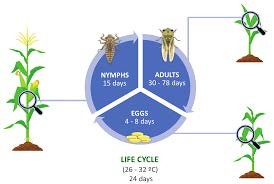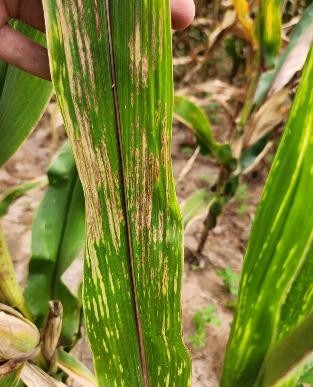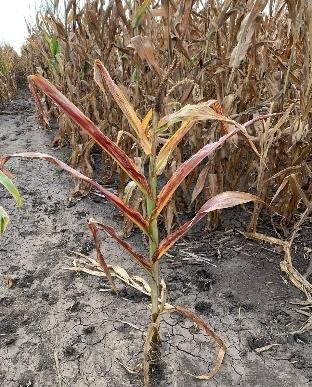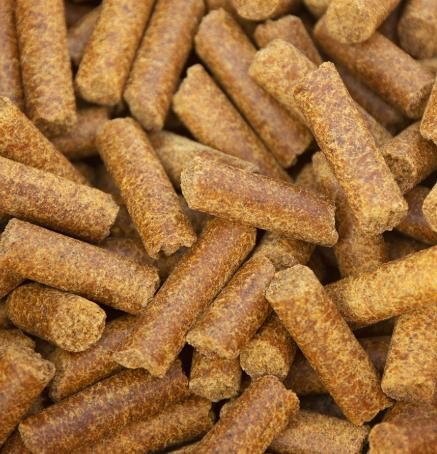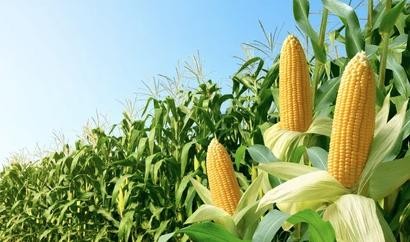Ag Insights April 2025
Tuesday, April 1, 2025
Corn Stunt, New Disease for Oklahoma Farmers
Josh Bushong, Area Extension Agronomist
In 2024, Oklahoma confirmed its first reports of corn leafhoppers (Dalbulus maidis) and corn stunt disease. The corn leafhopper and the disease symptoms were reported throughout the country last year. Corn stunt disease can result in deformed ears, reduced grain quality, and reduced yields. Corn symptoms include reddening of leaf tips, stunting, prolonged “stay-green”, yellow leaf streaks, multiple ears per plant, and missing or loose kernels.
The first step in any integrated pest management practice is proper identification.
Corn leafhoppers are small, tan or yellow insects, about 1/8 inch long. They can be
distinguished from other leafhoppers by the two dark spots between their eyes in adults.
They have a smooth head and a deeply indented V-shape in the hind margin of the first
thoracic segment. Both nymphs and adults feed on corn plants, particularly in the
young, shaded whorls. They tend to fly or jump when disturbed. They primarily spread
through wind-assisted movement, migrating northward from South America and up through
Mexico into the US.
While the corn leafhopper is only known to reproduce in corn, it can overwinter in various grasses, wheat, Johnsongrass, sorghum, soybean, and alfalfa. Females lay eggs in the leaf tissue, and nymphs hatch, progressing through five stages before becoming winged adults. Nymphs can emerge in about 2.5 days and will complete development within a few more days. Adults can live up to 78 days, with females laying around 15 eggs daily. Due to this rapid reproduction rate, leafhopper populations can increase quickly, causing significant damage to crops and spread of the disease.
Corn leafhoppers damage plants through direct plant feeding and by transmitting multiple pathogens that cause corn stunt disease. Additionally, they excrete honeydew, leading to black sooty mold that reduces photosynthesis and harms plant health. More critically, leafhoppers transmit three pathogens linked to corn stunt disease: two bacterial pathogens (corn stunt Spiroplasma (CSS) and maize bushy stunt phytoplasma (MBSP)) and a virus (maize rayado fino virus (MRFV). Yield losses are influenced by hybrid variety, growth stage of the corn, and pathogen aggressiveness. Diagnosing corn stunt requires advanced lab testing to determine which pathogens are causing the symptoms.
Pathogen transmission typically begins during early plant growth but shows symptoms only about 30 days after leafhopper feeding, once the plants enter reproductive stages. The most significant damage is stunted growth, shortened internodes, and the formation of small, defective ears. The primary bacterial pathogen, Spiroplasma kunkelii, is especially concerning as it can be transmitted to corn plants within minutes of leafhopper feeding. The pathogen will replicate inside the leafhopper’s gut for around 3 weeks, after which it can spread the disease for up to 1.5 months. Uninfected leafhoppers can contract the pathogen when feeding on infected plants leading to more rapid spread of the disease.
Management of corn leafhoppers is challenging due to the insect’s rapid reproduction and the disease’s complex transmission. There are not any hybrids with local genetics that have resistance. Cultural controls, such as early planting to allow crops to mature before leafhoppers arrive, are recommended. Removing volunteer corn plants after the season helps reduce overwintering sites. Research suggests that planting corn after crops like wheat may reduce leafhopper incidence, though more studies are needed.
Chemical control is largely ineffective once corn plants are infected, as symptoms appear weeks after feeding. Insecticides can control leafhoppers during early plant stages, but their effectiveness diminishes as the plants mature. Controlling the corn leafhopper for the first 40 days of the crop (VE to V8 growth stage) can limit the impact of the pathogens, but there are currently no thresholds or spray schedules determined yet as last year was the first known issue in Oklahoma. Pyrethroids and other broad-spectrum insecticides should be used with caution, as they can harm beneficial insects and natural predators.
As of March 12th, Dr. David Kerns of Texas A&M AgriLife Extension Service statewide IPM Coordinator and associate department head, reported confirmation of corn leafhoppers overwintering in volunteer corn and already being found in corn fields in the lower Rio Grande Valley. Both nymphs and adults were found in corn fields at the V5 to V6 growth stage, which also validates the reproduction of the corn leafhopper.
Ongoing monitoring will be shared as traps and field scouting reports continue into the season. Research at Oklahoma State University, led by Dr. Ashleigh Faris and Dr. Maira Duffeck, are working to better understand the impact of corn leafhoppers and corn stunt disease on local corn production. Management strategies will need to adapt based on further observations, and regional collaboration among corn farmers will be crucial for controlling the spread of both the insect, and the disease. More information can be found from the OSU factsheet EPP-23-17.
Rabies in Farm Animals
Barry Whitworth, DVM
Senior Extension Specialist/BQA State Coordinator, Department of Animal & Food Sciences, Ferguson College of Agriculture
According to Dr. Rod Hall, State Veterinarian with the Oklahoma Department of Agriculture, Food and Forestry (ODAFF), a show calf began showing symptoms of excessive salivation and vocalization. The owners separated it from the other show calves as soon as they recognized there was something wrong with it. The calf’s condition deteriorated, and it was euthanized and the brain submitted to OADDL for rabies testing. OADDL confirmed rabies in the calf. This is a reminder to all livestock producers of the importance of vaccinating animals that have close contact with humans.
Rabies is a virus in the genus Lyssavirus in the family Rhabdoviridae. Rabies virus does not survive in the environment for very long. Most disinfectants will kill the virus, but with very few exceptions the disease is fatal to animals and humans. Domestic animals are infected with the virus from wildlife reservoirs. According to Dr. LeMac Morris, State Veterinarian with the Oklahoma State Department of Health (OSDH), the most common reservoirs in Oklahoma are skunks and bats. Other reservoirs in the United States are foxes, raccoons, and coyotes.
It is estimated that worldwide 50,000 to 60,000 people die of the disease each year. Most of the human rabies cases in the world are caused by dog bites. According to the Center for Disease Control and Prevention (CDC), the leading cause of rabies in humans in the United States is exposure to bats. Unfortunately, many of those that die due to rabies are not even aware of being exposed to the virus. Dr. LeMac Morris recommends that anyone who has questions about exposure to rabies contact the OSDH at (405) 426-8710 and ask to speak with Epi-on-Call. The Epidemiologist is available 24/7 and will assist in determining if an individual needs Post Exposure Prophylaxis (PEP).
In order for an animal to be infected with the virus, it must come in contact with the saliva from a rabid animal. This normally occurs from a bite. The virus may gain entry by saliva coming in contact with a mucous membrane or a break in the skin. Aerosol transmission has been reported in laboratories and bat caves, but this is very rare. Once in the body, the virus replicates in the muscle tissue. Next, the virus enters the peripheral nerves and is transported to the spinal cord and to the brain. Once in the brain, the virus enters the systemic circulation which includes the salivary glands. The timeline for all this to take place is variable.
The clinical disease in animals will be in one of two forms, furious or paralytic. The furious form of the disease is the most recognized by people. Animals with this form will be restless, wander, vocalize, drool, and attack anything in sight. These animals are not afraid of anything. Nocturnal animals with rabies are often seen in the day. They will have convulsions in the late stages of the disease. They usually die 4 to 8 days after showing clinical signs.
The paralytic (dumb) form of the disease is a progressive paralysis. In these animals, the throat is paralyzed and the animal cannot swallow or vocalize normally. Cattle might have a high-pitched bellow or attempt to bellow with no sound being produced. Due to the progressive paralysis, rumination will cease which may result in bloat. They also may appear to be straining to urinate or defecate. These animals will have problems walking and will become recumbent. This form is often mistaken as a digestive problem. Some producers may think the animal is aborting or has a urinary problem. Unfortunately, many producers have been exposed to rabies because they do not recognize that this animal was infected with the “dumb” form of rabies. These animals usually die in 2 to 6 days from respiratory failure.
When an animal has neurological signs, rabies should be suspected. Producers should avoid contact with the animal and contact their local veterinarian. If the veterinarian suspects rabies, he/she will not treat the animal since the condition is fatal and the danger to humans is not worth the risk of treatment. To confirm the diagnosis of rabies, a veterinarian will submit the brain for testing.
Rabies can be prevented by vaccination and by preventing unnecessary exposure of domestic animals to wildlife. All pets should be vaccinated. Obviously, vaccinating a large herd or flock of animals would not be cost effective. However, animals that are in constant contact with humans such as show animals, a family milk cow, or horses should be vaccinated. Preventing contact with wildlife is difficult but keeping the farm clean and free of food sources should discourage wildlife from entering areas where animals are kept.
Rabid animals are dangerous. If animals have a furious form, they may attack and injure producers. Animals with the dumb form of the disease can infect unsuspecting producers. Anytime an animal is suspected of having rabies, a veterinarian should be contacted. As stated earlier, most people who are exposed and/or die of rabies in the US are not even aware that they have been exposed. More information about rabies is available at the CDC. For additional information on rabies, livestock producers should contact their local veterinarian and/or their local Oklahoma State University Cooperative County Extension Agriculture Educator.
New Distiller’s Extruded Cube for Summer Supplementation
Dana Zook, NW OK Area Livestock Specialist
It might seem a little early to be thinking about summer but as the green grass makes
its way out of our dormant range it’s a good time to consider summer feeding strategies.
In the past several years, Oklahoma State University has been working on research
evaluating a new form of a dried distiller’s grains supplement. This supplement isn’t
totally new to Oklahoma Livestock producers. Dried distiller’s grains is a byproduct
of the ethanol industry and this product has been available in Oklahoma for many years.
This new form includes 100% Dried Distiller’s Grains and has been “cubed” using a
new extrusion process. Researchers from OSU have been working primarily with Masterhand
Milling to supply this product to complement all different types of forages. Historically,
DDG’s, (Dried Distiller’s Grains) were available as cubes and pellets but many of
them had very poor quality, ending up being more of a “crumble”. Due to it’s fine
texture, this form was not ideal for feeding on the ground as 10-25% was often lost.
Some producers utilized bunks for feeding this product, but this is not conducive
to rotating feeding areas. Areas where bunks were
used were often sacrificed and range was highly damaged due to trampling, mud, and
overuse. This new extruded distiller’s cube has a good structure, allowing it to be
fed on the ground in all range conditions. The benefits of this feed product extend
beyond the structure. Due to the heat extrusion process, there is a slight increase
in measurable crude protein, energy, and fat. This was confirmed by a small research
project which took DDG samples before and after the extrusion process. The final feed
quality of the DDG Extruded cube in the study was 34% crude protein and 92% TDN.
In addition to nutritive quality, Oklahoma State researchers evaluated this feed product when fed in several different range conditions across the state. One such study looked at early and late summer supplementation to cattle at the Klemme Range Research Station in Bessie, OK and the ARS Station near Ft. Supply. At Klemme, cattle (~583 lbs.) were stocked at 7 acres per head and supplemented at 3 different levels: an un-supplemented control group, 2 pounds of DDG cubes daily or 4 pounds of DDG cubes daily. In Ft. Supply, cattle (~651 lbs.) were stocked at 5 acres/head also supplemented at these levels but also at 6 lbs. of DDG cubes daily.
Cattle performed well across the board. At Klemme in early summer, calves supplemented at 2 and 4 pounds per day performed nearly equal at 2.22 and 2.24 pounds ADG. This gain was approximately 0.45 greater than daily gain of calves receiving no supplement. In late summer, calves fed 2 pounds/day gained an average of 1.64 pounds/day and calves fed 4 pounds DDG supplement per day maintained at 2.21 pounds ADG.
At Ft. Supply in early summer, cattle receiving no supplement gained 1.87 pounds daily. The groups being supplemented 2, 4, and 6 pounds DDG cubes gained 2.91, 3.29, and 3.65 pounds respectively. In late summer, gains were tempered, supplemented calves gaining no different than un-supplemented animals who gained 2.34 pounds per day.
At Ft. Supply in early summer, cattle receiving no supplement gained 1.87 pounds daily. The groups being supplemented 2, 4, and 6 pounds DDG cubes gained 2.91, 3.29, and 3.65 pounds respectively. In late summer, gains were tempered, supplemented calves gaining no different than un-supplemented animals who gained 2.34 pounds per day. In the past, the Oklahoma Gold and Super Gold Programs were the gold standard in supplying high and moderate protein supplements to cattle to maintain gains when grass quality decreases in the late summer. This study found that both early and late summer gains were complemented by the 34% protein DDG cube. The partnership of highly digestible protein and energy in the feed product offers an almost perfect package for supplementing on range. The late summer Ft. Supply data is puzzling but more information in coming down the pike about these studies so stay tuned! If you would like to hear more about this new supplement, tune into the recent episodes of the Extension Experience Podcast where I interview Dr. Paul Beck about his findings. Listen on your computer or subscribe to the show on Apple podcasts and Spotify. Have a great April and talk to you soon!
Corn Outlook and Local Cost Return Budget
Alberto Amador, Area Ag Economics Specialist
Global corn production remains solid. In the 2023/24 marketing year, production was 5% higher than the previous year, reaching 48.34 billion bushels. However, forecasts for 2024/25 project a decline to 47.71 billion bushels, with no changes from last month’s estimate. Foreign production is expected to decrease compared to the previous year, principally lower expectations in South America, particularly Argentina and Brazil, where unfavorable weather conditions and unusual precipitation have delayed corn planting. Additionally, yield expectations have declined in Mexico due to lower winter corn yield and South Africa due to a reduced planting area. Despite these factors, the foreign production forecast for March was raised compared to the previous month driven by an increased production expectation from India, Russia, and Ukraine.
Regarding demand, the forecast does not indicate a significant change in global consumption. However, global corn trade projections for 2024/25 show notable adjustments. Corn exports are expected to decline 3% compared to last year and 2% compared to last month, reaching 7.34 billion bushels in March 2025. The primary reason for this reduction is lower exports from Brazil and South Africa.
Although the updated report suggested Argentina could compensate this decline, a sever rain disaster impacted a key port just day before the report was published. On the other hand, global corn imports are projected to be 9% lower than the previous year. While Turkey, Vietnam, Colombia and Egypt have increased their imports expectations, China and Taiwan have significantly reduced theirs. The largest impact comes from China where imports have dropped from 905.5 million bushels to 393.7 million bushels. As a result of these shifts in global trade, Ending Stocks for 2024/25 are projected to be 8% lower than the previous year, totaling 11.37 billion bushels.
The U.S. has a strong corn supply, with a record-high yield of 179 bushels per harvested acre in 2024/25. Total production is expected to reach 14,867 million bushels, which, while lower than the previous year, is still higher than pre-Covid levels. Whereas the global trade faces uncertainties due to tariff implementations and geopolitical factors, U.S. corn exports are expected to increase by over 150 million bushels reaching 2,450 million bushels. So far, trade relations with the largest buyers, Mexico and Japan, remain stable. Domestic consumption remains stable with 46% allocated to feed and residuals, 11% to food, seed, and industrial use (such as starch and alcohol), and 43% to Ethanol production.
In recent years, prices have fluctuated, rising from 2020 to 2023. However, during the last quarter of 2024, corn prices fell compared to previous years. While current prices remain above pre-Covid levels, they are trending downward. Given global trade expectations, prices are likely to experience a slight decline, potentially diminishing profit margins if input costs remain stable or increase marginally.
Break-Even point analysis and What-If tools are valuable for managing volatility. According to USDA, the market year average price for corn in 2025 is projected to be $4.35, which is $0.11 higher than the established reference price for corn. Therefore, it’s crucial to stay updated for future price predictions and explore different scenarios, especially with the safety net programs enrollment deadline approaching.
With the intention to provide a baseline for the break-even point, I calculated the cost per acre for corn with local input prices. Also, I explored multiple scenarios with different yields and prices. The price used in this analysis is based on the MYA price 2025, estimated by USDA. The following tables present the returns over direct and total costs and the break-even price for each yield. I would like to emphasize that some input prices are subject to change, and fixed costs vary from farm to farm. However, this analysis provides a solid starting point for understanding the economic landscape.
| Yields bu/acre | $4.26/bu. | $4.35/bu. | $4.46/bu. |
|---|---|---|---|
| 70 | $7 | $13 | $21 |
| 80 | $46 | $53 | $62 |
| 90 | $85 | $93 | $103 |
| 100 | $120 | $129 | $140 |
| Yields bu/acre | $4.26/bu. | $4.35/bu. | $4.46/bu. |
|---|---|---|---|
| 70 | -$105 | -$99 | -$91 |
| 80 | -$66 | -$59 | -$50 |
| 90 | -$27 | -$19 | -$9 |
| 100 | $8 | $17 | $28 |
| 70 | 80 | 90 | 100 | |
|---|---|---|---|---|
| Above Variable Costs | $4.16 | $3.69 | $3.32 | $3.06 |
| Above Total Costs | $5.76 | $5.09 | $4.56 | $4.18 |
Extension Experience – Insights into Oklahoma Agriculture
The Extension Experience podcast is brought to you by Josh Bushong and Dana Zook. Biweekly episodes provide perspectives on Agriculture topics and offer insight from our experience working with OSU Extension Educators and producers across Oklahoma.
The Extension Experience podcast is available on Spotify and Apple Podcast platforms.
You can also access the episodes on our blog.
You can also find and share our podcast from our Facebook page!
We hope you consider listening to the Extension Experience.


